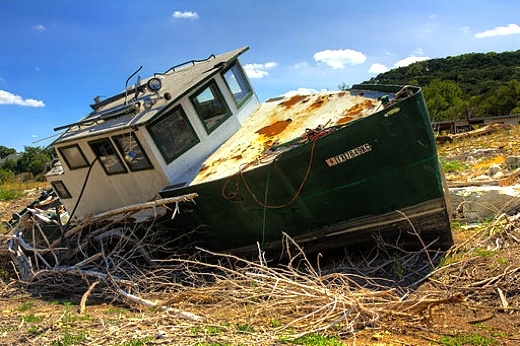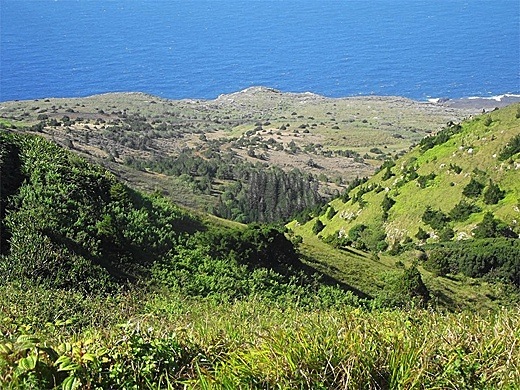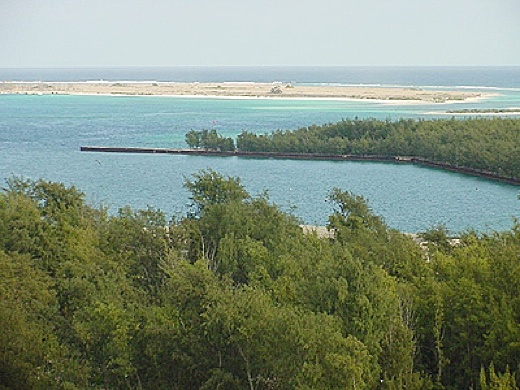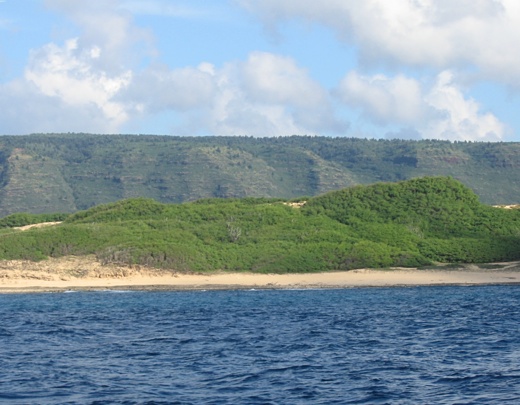SUBHEAD: Obama urged by Democrats to use executive order to recognize Hawaiians like native Indians. And you know how well that worked out for the indigenous Americans.
By Valerie Richardson on 22 August 2013 for The Washington Times -
(http://www.washingtontimes.com/news/2013/aug/22/obama-urged-to-use-executive-order-to-recognize-na)

Image above: Hawaiian Tribe Casino in Honolulu circa 2015. Mashup of Herb Kane painting and casino image by Juan Wilson.
Democrats are urging President Obama to bypass Capitol Hill once again and accomplish by executive order what Congress refused to do for 13 years: grant formal federal tribal recognition to Native Hawaiians.
The effort lost its most visible champion in January when Sen. Daniel K. Akaka, Hawaii Democrat, retired without having won passage for his namesake legislation, the so-called Akaka bill. The measure has not been introduced in the current Congress.
Even so, the timing may never be better for action: Mr. Obama, who grew up in Hawaii, has indicated his support for the Akaka bill. He also has shown a willingness to use his executive authority to bypass Congress on a host of issues including health care, welfare reform, immigration and climate change.
“The president is being asked to consider a number of potential executive actions,” Sen. Brian Schatz, Hawaii Democrat, told the (Honolulu) Star-Advertiser last week. “That could take many forms, including something by the Department of Interior, or at the secretary level or something at the presidential level.”
Supporters, including the all-Democrat Hawaiian delegation, say the recognition is needed to ensure that Native Hawaiians continue to receive special services in health care, job training and education .
.
Opponents argue that the measure sanctions race-based discrimination and would set a precedent for establishing divisive, racially separate societies. Some even fear the designation could open the island to gambling operations along the lines of Indian tribe concessions run on the mainland.
“Hawaiians have never been defined by race or by blood. They’ve always been inclusive,” said Keli'i Akina, president of the free-market Grassroot Institute of Hawaii, which opposes the Akaka bill. “The establishment of a race-based entity is not Hawaiian.”
First introduced in 2000, the Akaka bill was approved by the House three times, most recently in 2010, but the measure never passed the Senate. Among its chief critics during the latest vote was Rep. Doc Hastings, Washington Republican and chairman of the House Committee on Natural Resources.
Committee spokeswoman Jill Strait said in an email that the executive branch has no authority to establish a Native Hawaiian tribe.
that the executive branch has no authority to establish a Native Hawaiian tribe.
“Aside from the fact that extending federal recognition to Native Hawaiians as a kind of Indian tribe would be an unconstitutional race-based action, Congress is deemed by the Supreme Court to have exclusive and plenary power to deal with Indian affairs,” said Ms. Strait. “It would therefore be an abuse of power for the executive branch to attempt to extend federal recognition to a Native Hawaiian governing entity.”
to deal with Indian affairs,” said Ms. Strait. “It would therefore be an abuse of power for the executive branch to attempt to extend federal recognition to a Native Hawaiian governing entity.”
The Hawaiian government, controlled by Democrats, is moving to assist the administration. In 2011, the state Legislature established a registry of Native Hawaiians through the Office of Hawaiian Affairs, asking anyone with such ancestry to sign the roll, known as Kana’iolowalu.
Only about 9,300 had registered after a year — the 2010 census estimates there are about 527,000 Native Hawaiians — prompting the Legislature to extend the deadline and allow the office to add unilaterally the names of anyone who had signed other lists of Native Hawaiians.
Ken Conklin, a prominent critic of the Akaka bill, said the measure is an attempt to evade legal challenges aimed at the Office of Hawaiian Affairs‘ entitlement programs for Native Hawaiians. Declaring them an Indian tribe would allow the agency to avoid that dilemma, but doing so would create a host of other problems.
“Where would their sovereign lands be?” said Mr. Conklin. “The percentage of ethnic Hawaiians in Hawaii is 21 percent. They live everywhere: They’re in all the neighborhoods, they’re fully assimilated in the economy at all levels. It’s just unimaginable.”
Meanwhile, the Interior Department is engaged in efforts to reform the tribal recognition process, which opponents fear could include the removal of roadblocks to granting status to Native Hawaiians.
Supporters say tribal recognition is needed to ensure that Native Hawaiians have the same rights as other native groups, namely Indian tribes on the U.S. mainland. The Star-Advertiser came out in support of the executive path in an editorial Tuesday.
“The so-called Akaka Bill aimed at achieving Hawaiian sovereignty has been stalled more than a decade in Congress because of opposition by Senate Republicans, leaving the most realistic approach to be executive order,” said the newspaper. “Hawaii’s Democratic delegation is wisely pursuing that approach while Hawaii-born President Barack Obama remains in the White House.”
Public opinion on the idea remains lukewarm. A 2009 Zogby poll found that 58 percent wanted voters to cast ballots on the Akaka bill and that 51 percent opposed it and 34 percent supported it.
An unscientific online poll conducted last week by the Star-Advertiser found that 70 percent of 3,104 votes cast opposed having Mr. Obama enact the Akaka bill by fiat, while 30 percent supported the idea.
Critics note that if the Akaka Bill is approved by executive order, it could be just as easily undone in the next administration. By then, however, a separate Native Hawaiian government may be entrenched on the islands of the 50th state.
“We all know President Obama has done an awful lot of executive-order kind of things,” said Mr. Conklin. “He doesn’t have the right or the authority, but there he is, doing it.”

Image above: Hawaii Gov. Neil Abercrombie (right) and Lt. Gov. Brian Schatz sign a petition supporting Native Hawaiian sovereignty in Honolulu in July 2012. Remember the PLDC when you consider the motives of these two snakes. From original article.
.
By Valerie Richardson on 22 August 2013 for The Washington Times -
(http://www.washingtontimes.com/news/2013/aug/22/obama-urged-to-use-executive-order-to-recognize-na)

Image above: Hawaiian Tribe Casino in Honolulu circa 2015. Mashup of Herb Kane painting and casino image by Juan Wilson.
Democrats are urging President Obama to bypass Capitol Hill once again and accomplish by executive order what Congress refused to do for 13 years: grant formal federal tribal recognition to Native Hawaiians.
The effort lost its most visible champion in January when Sen. Daniel K. Akaka, Hawaii Democrat, retired without having won passage for his namesake legislation, the so-called Akaka bill. The measure has not been introduced in the current Congress.
Even so, the timing may never be better for action: Mr. Obama, who grew up in Hawaii, has indicated his support for the Akaka bill. He also has shown a willingness to use his executive authority to bypass Congress on a host of issues including health care, welfare reform, immigration and climate change.
“The president is being asked to consider a number of potential executive actions,” Sen. Brian Schatz, Hawaii Democrat, told the (Honolulu) Star-Advertiser last week. “That could take many forms, including something by the Department of Interior, or at the secretary level or something at the presidential level.”
Supporters, including the all-Democrat Hawaiian delegation, say the recognition is needed to ensure that Native Hawaiians continue to receive special services in health care, job training and education
Opponents argue that the measure sanctions race-based discrimination and would set a precedent for establishing divisive, racially separate societies. Some even fear the designation could open the island to gambling operations along the lines of Indian tribe concessions run on the mainland.
“Hawaiians have never been defined by race or by blood. They’ve always been inclusive,” said Keli'i Akina, president of the free-market Grassroot Institute of Hawaii, which opposes the Akaka bill. “The establishment of a race-based entity is not Hawaiian.”
First introduced in 2000, the Akaka bill was approved by the House three times, most recently in 2010, but the measure never passed the Senate. Among its chief critics during the latest vote was Rep. Doc Hastings, Washington Republican and chairman of the House Committee on Natural Resources.
Committee spokeswoman Jill Strait said in an email
“Aside from the fact that extending federal recognition to Native Hawaiians as a kind of Indian tribe would be an unconstitutional race-based action, Congress is deemed by the Supreme Court to have exclusive and plenary power
The Hawaiian government, controlled by Democrats, is moving to assist the administration. In 2011, the state Legislature established a registry of Native Hawaiians through the Office of Hawaiian Affairs, asking anyone with such ancestry to sign the roll, known as Kana’iolowalu.
Only about 9,300 had registered after a year — the 2010 census estimates there are about 527,000 Native Hawaiians — prompting the Legislature to extend the deadline and allow the office to add unilaterally the names of anyone who had signed other lists of Native Hawaiians.
Ken Conklin, a prominent critic of the Akaka bill, said the measure is an attempt to evade legal challenges aimed at the Office of Hawaiian Affairs‘ entitlement programs for Native Hawaiians. Declaring them an Indian tribe would allow the agency to avoid that dilemma, but doing so would create a host of other problems.
“Where would their sovereign lands be?” said Mr. Conklin. “The percentage of ethnic Hawaiians in Hawaii is 21 percent. They live everywhere: They’re in all the neighborhoods, they’re fully assimilated in the economy at all levels. It’s just unimaginable.”
Meanwhile, the Interior Department is engaged in efforts to reform the tribal recognition process, which opponents fear could include the removal of roadblocks to granting status to Native Hawaiians.
Supporters say tribal recognition is needed to ensure that Native Hawaiians have the same rights as other native groups, namely Indian tribes on the U.S. mainland. The Star-Advertiser came out in support of the executive path in an editorial Tuesday.
“The so-called Akaka Bill aimed at achieving Hawaiian sovereignty has been stalled more than a decade in Congress because of opposition by Senate Republicans, leaving the most realistic approach to be executive order,” said the newspaper. “Hawaii’s Democratic delegation is wisely pursuing that approach while Hawaii-born President Barack Obama remains in the White House.”
Public opinion on the idea remains lukewarm. A 2009 Zogby poll found that 58 percent wanted voters to cast ballots on the Akaka bill and that 51 percent opposed it and 34 percent supported it.
An unscientific online poll conducted last week by the Star-Advertiser found that 70 percent of 3,104 votes cast opposed having Mr. Obama enact the Akaka bill by fiat, while 30 percent supported the idea.
Critics note that if the Akaka Bill is approved by executive order, it could be just as easily undone in the next administration. By then, however, a separate Native Hawaiian government may be entrenched on the islands of the 50th state.
“We all know President Obama has done an awful lot of executive-order kind of things,” said Mr. Conklin. “He doesn’t have the right or the authority, but there he is, doing it.”

Image above: Hawaii Gov. Neil Abercrombie (right) and Lt. Gov. Brian Schatz sign a petition supporting Native Hawaiian sovereignty in Honolulu in July 2012. Remember the PLDC when you consider the motives of these two snakes. From original article.
.











